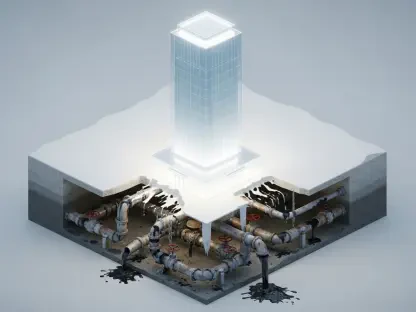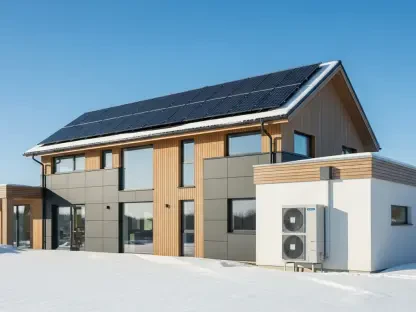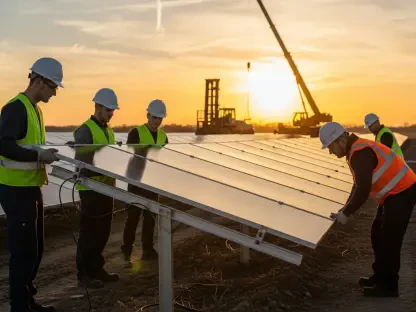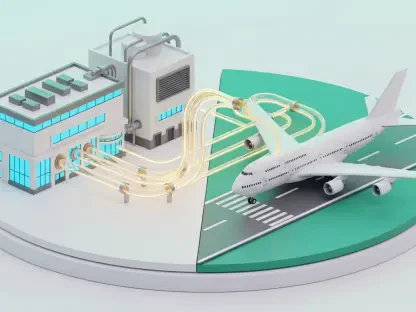In a sweeping and determined push, the current administration under President Donald Trump has initiated a series of policy changes that have sent shockwaves through the renewable energy sector in the United States, marking a stark departure from the previous administration’s commitment to decarbonizing the nation’s electricity grid. With a clear focus on dismantling the progress made in wind and solar energy development, these actions—from halting major projects to slashing subsidies—signal a significant pivot in national energy priorities. This shift has raised concerns among industry stakeholders about the future of clean energy and its role in combating climate change. As developers grapple with new barriers, the broader implications for jobs, investments, and energy security come into sharp focus. This unfolding scenario demands a closer look at the specific policies, their immediate impacts, and the long-term consequences for a sector once poised for rapid growth.
Policy Shifts and Regulatory Barriers
The administration’s approach to renewable energy became evident almost immediately after taking office, with a decisive action on January 20 to pause new leasing and permitting for wind projects on federal lands and waters. This early move set the tone for a broader strategy aimed at curbing the expansion of clean energy initiatives. Subsequent decisions, such as the April 17 suspension of a major offshore wind project off New York, underscored a pattern of targeting high-profile developments. By May 14, the reversal of fee reductions for solar and wind projects on federal lands introduced financial hurdles that developers had not anticipated. These regulatory changes, layered with additional scrutiny announced on July 17, have created a challenging environment where project timelines are delayed, and costs are escalating. The cumulative effect of these barriers is a slowdown in the momentum that the renewable sector had built over recent years, raising questions about the feasibility of meeting national climate goals.
Beyond the initial halts and fee adjustments, the administration has employed a multi-agency effort to tighten the grip on renewable energy growth. On August 6, the cancellation of a significant wind project in Idaho due to legal and community concerns highlighted how local opposition can be leveraged to stall progress. Just a day later, on August 7, the termination of a $7 billion grant program aimed at supporting solar energy in low-income communities dealt a severe blow to accessibility initiatives. Further tightening came on August 15 with new Treasury Department rules that restricted tax credit eligibility, making it harder for developers to secure funding. These coordinated actions across various federal departments demonstrate a deliberate intent to reshape the energy landscape, prioritizing other forms of energy production over renewables and leaving many in the industry scrambling to adapt to an increasingly hostile policy framework.
Legislative Actions and Financial Disincentives
A pivotal moment in the administration’s campaign against renewables occurred on July 4 with the signing of a major legislative act that prematurely ended subsidies for wind and solar projects. This decision is projected to have far-reaching consequences, slashing installations, reducing investments, and eliminating thousands of jobs in the clean energy sector. Analysts warn that the abrupt removal of financial support could exacerbate power supply shortages, especially in regions heavily reliant on renewable sources for grid stability. The ripple effects are already being felt, as developers reassess the viability of planned projects and scale back ambitions. This legislative blow has not only disrupted the economic foundation of the industry but also signaled to global partners that the United States may be stepping back from its leadership role in the transition to cleaner energy solutions.
In addition to subsidy cuts, the administration has introduced policies that further strain the financial outlook for renewable energy companies. On August 18, the Agriculture Department restricted support for renewable projects on farmland, limiting the scope of potential development sites. Meanwhile, the Commerce Department’s investigation into imported wind turbine components, launched on August 21, has raised concerns about supply chain disruptions and increased costs. These measures, combined with an executive order on August 22 to halt a nearly completed wind farm off Rhode Island citing national security, illustrate a comprehensive strategy to discourage investment. The financial disincentives, paired with regulatory uncertainty, have created a climate where even the most resilient companies are reevaluating their commitments to the American market, potentially ceding ground to international competitors in the global race for clean energy innovation.
Project Cancellations and Industry Fallout
The targeted cancellation of specific renewable energy projects has become a hallmark of the administration’s energy policy. On August 25, the intent to revoke approvals for a major offshore wind project off Maryland was announced, further eroding confidence in the sector’s stability. This follows a pattern of suspensions and terminations, such as the earlier halt of projects in New York and Idaho, which collectively paint a picture of systematic opposition to both onshore and offshore developments. The impact on developers is profound, with millions in sunk costs and delayed returns on investment. Communities that anticipated economic boosts from these projects are left in limbo, grappling with the loss of promised jobs and infrastructure. The cascading effects touch not only the companies directly involved but also suppliers, contractors, and ancillary businesses that form the backbone of the renewable energy ecosystem.
The fallout from these cancellations extends beyond immediate economic losses to broader environmental and societal implications. Industry experts note that the stalling of wind and solar projects undermines efforts to reduce greenhouse gas emissions, a critical component of national and global climate strategies. With each project delayed or scrapped, the timeline for transitioning to a decarbonized grid grows more uncertain, potentially locking in reliance on fossil fuels for years to come. Additionally, the loss of federal support has chilled investor enthusiasm, as the risk profile for renewable ventures in the United States spikes. This dynamic threatens to cede technological and economic leadership to other nations prioritizing clean energy, while domestic stakeholders face an uphill battle to maintain momentum in an increasingly constrained market. The long-term consequences of these disruptions remain a pressing concern for policymakers and advocates alike.
Reflecting on a Changed Energy Landscape
Looking back, the rapid succession of policy reversals and project terminations under this administration marked a defining chapter for the renewable energy sector. The deliberate dismantling of federal support through regulatory, legislative, and financial mechanisms reshaped the trajectory of wind and solar development in a matter of months. As the dust settled on halted initiatives and slashed subsidies, the industry confronted a reality far removed from the optimistic projections of previous years. Moving forward, stakeholders must pivot toward innovative financing models and state-level partnerships to sustain progress. Advocacy for policy reconsideration, alongside investment in resilient technologies, could offer pathways to mitigate past setbacks. Ultimately, navigating this altered landscape will require collaboration across sectors to ensure that the pursuit of a cleaner, more sustainable energy future remains within reach despite the challenges encountered.









